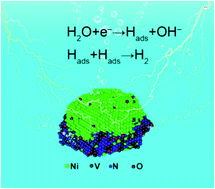Supporting nickel on vanadium nitride for comparable hydrogen evolution performance to platinum in alkaline solution†
Abstract
The hydrogen evolution reaction (HER) is an effective means to producing hydrogen from electrolytic water splitting. However the best-performing catalysts use expensive Pt-group metals. Cheaper non-precious metal alternatives have shown low activity as their mechanism of H2 formation (Volmer–Heyrovsky) leads to high overpotentials. Here, we report an outstanding HER catalyst (Ni/VN) highly dispersed nickel supported on vanadium nitride that matches the turnover frequency of the platinum on carbon (Pt/C) benchmark material. It is more durable than Pt/C in alkaline solution. Ni/VN follows the low-overpotential (Volmer–Tafel) mechanism of H2 formation, with a 43 mV overpotential at a current density of 10 mA cm−2. This value is even below that of Pt/C (57 mV). The support of VN enhances the dispersion of nickel, weakens the surface oxidation, decreases the hydrogen binding energy, and therefore significantly improves the HER catalysis. This result removes one of the major barriers for scalability of electrolytic water-splitting by demonstrating that nitride-based materials can match and even surpass the efficiency and durability of precious metal catalysts.

- This article is part of the themed collection: Journal of Materials Chemistry A Emerging Investigators


 Please wait while we load your content...
Please wait while we load your content...